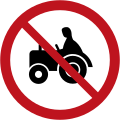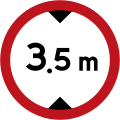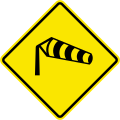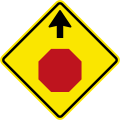Regulatory signs
Regulatory signs are used to inform the road users of various restrictions. Unless otherwise is indicated on an additional panel, the restriction starts to apply at the point the sign is erected.
Priority signs
- R1
Give way (without inscription) - R1-1
Give way (with inscription) - R2
Stop sign
Prohibitory signs
- R7
Closed to all vehicles in both directions - R8
No entry - R9
No motor vehicles - R10
No motor vehicles, except for two-wheeled motorcycles without side-car - R11
No motorcycles - R12
No pedal cycles - R13
No mopeds - R14
No goods vehicles - R15
No vehicles pulling a trailer, except for semi-trailers or single axle trailers - R16
No vehicles pulling a trailer - R17
No pedestrians - R18
No animal-drawn vehicles - R19
No handcarts - R20
No agricultural vehicles - R21
No vehicles exceeding 2.2 metres in width - R22
No vehicles exceeding 3.5 metres in height - R23
No vehicles exceeding 12 tonnes - R24
No vehicles exceeding 6 tonnes per axle - R25
No vehicles exceeding 12 metres in length - R26
No right turn - R27
No left turn - R28
No U-turn - R29
No overtaking - R30
No overtaking by goods vehicles - R31
End of the overtaking prohibition - R32
End of the overtaking prohibition for goods vehicles - R33
Speed limit (20 km/h) - R33
Speed limit (30 km/h) - R33
Speed limit (40 km/h) - R33
Speed limit (50 km/h) - R33
Speed limit (60 km/h) - R33
Speed limit (70 km/h) - R33
Speed limit (80 km/h) - R33
Speed limit (90 km/h) - R33
Speed limit (100 km/h) - R33
Speed limit (110 km/h) - R34-1
Use of audible warning devices prohibited - R34-2
Silence zone - U1-2
One-way road (left) - U1-1
One-way road (right)
Mandatory signs
- R35-1
Turn right - R35-2
Turn left - R35-3
Proceed straight ahead - R35-4
Turn right ahead - R35-5
Turn left ahead - R35-6
Proceed straight or turn right ahead - R35-7
Proceed straight or turn left ahead - R35-8
Turn left or right ahead - R36-1
Keep left - R36-2
Keep right - R36-3
Pass on either side - R37
Roundabout - R38
Cycle path - R39
Footpath - R40
Horse riding path
Parking and stopping signs
- R41
No parking - R42
No stopping





















































































































